Dinosaurs are thought to have roamed the Earth for 150 million years, only to be wiped out in the Cretaceous period (146-65 million years ago). Today, fossils, bones and footprints from these amazing creatures give us an insight into what they might have looked like and how they may have lived.
- Introduction to the early world
- Types of dinosaurs
- Dinosaurs in Australia
- What happened to the dinosaurs?
- Dinosaur fast facts
- References
A printable PDF of the information on this page is available in the right-hand column.
Introduction to the early world
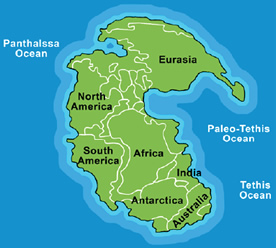
Have you heard of Pangaea (sometimes spelt Pangea)? It is the name for a single landmass that was thought to have existed about 300 million years ago. It incorporated North America, South America, Europe, Asia, Antarctica and Australia. The name comes from the Ancient Greek: pan meaning ‘entire’ and gaia meaning ‘earth’.
Pangaea began to break apart to eventually form the Earth’s major continents as we know them today. This process is called continental drift and was occurring at the same time as dinosaurs were thought to be roaming the earth.
Types of dinosaurs
Dinosaurs are very much like reptiles; they have tough scaly skin and most would have laid eggs. As well as their tough skin, many dinosaurs had built-in armour. Dinosaurs had four limbs.
All dinosaurs lived on land (see the ‘Dinosaurs fast facts’ section to find out more about prehistoric water and air animals). They either walked on two hind legs (this is called bipedal) or all four legs (this is called quadrupedal). Some dinosaurs were strictly plant eating (herbivores), others were meat eating (carnivores), and others ate both (omnivores).
Scientists have recognised from dinosaur skeletons that their pelvic (hip) bones resemble either those of lizards or of birds. Scientists divide dinosaurs into two categories based on these bones:
- Saurischia, for lizard-hipped dinosaurs.
- Ornithischia for bird-hipped dinosaurs.
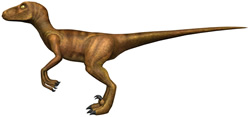
Dinosaurs in the lizard-hipped Saurischia group are divided into two groups:
- Theropoda – fearsome, bipedal carnivores. Two well-known examples of Theropoda are the Tyrannosaurus Rex and the Velociraptor.
- Sauropodomorpha – quadrupedal herbivores. The Brachiosaurus is probably the best-known Sauropodomorpha.
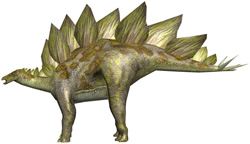
The bird-hipped Ornithischia are divided into four groups:
- Ornithopoda – medium to large bird-footed herbivores. Iguanadon is an example of an Ornithopod.
- Stegosauria – plated lizards. The Stegosaurus is a famous member of this group.
- Ankylosauria – armoured lizards. Not surprisingly, the Ankylosaurus is an Ankylosauria.
- Ceratopsia – horned faces. Perhaps the most famous example of a horn-faced dinosaur is the Triceratops.
Dinosaurs in Australia
Although some dinosaur bones and fossils have been discovered in every Australian state and territory apart from Tasmania and the Northern Territory, Australia’s landscape is not suitable for preserving the remains of dinosaurs. Fossils usually occur in areas that have been built upon over time, for example in mountainous regions, so the flat, exposed landscape of Australia has not provided too many fossil finds.
Australia does, however, have a very good record of preserving the fossils of the ancient sea creatures that lived alongside the dinosaurs. This is because much of Australia used to be covered by an inland ocean.
Queensland
Most Australian dinosaur bones come from Queensland, where bones estimated to be from the Early Cretaceous Period (around 140 million years ago) have been found in rocks. The fossils found indicate that the following dinosaurs lived in Queensland:
- Minmi the Ankylosaur
Minmi, as she was named, would have been two metres long, one metre tall, and covered in bony armour to protect her from predators. She was a herbivore who walked on all four legs. Muttaburrasaurus the Iguanadont
Muttaburrasaurus was named after the place he was found – Muttaburra, Queensland. He was a huge herbivore, up to eight metres tall, with a beak and sharp teeth for eating plants.- Two Sauropods – Rhoetosaurus brownei and Elliot the Austrosaurus mckillopi
Even though the skeletons of these two dinosaurs were incomplete, scientists could tell that they were both large dinosaurs. Rhoetosaurus brownei is thought to have been up to 17 metres in length and to have weighed about 20 tonnes (an average-sized car weighs about 1.5 tonnes). Elliot’s thigh bone caused scientists to believe he would have been up to 21 metres in length. He weighed around 25 tonnes.
Dinosaur stampede

We are very fortunate to have an incredible moment in time preserved at Lark Quarry, Queensland.
Around 95 million years ago, during the Cretaceous period, a large dinosaur ran through a flock of 180 bird-sized carnivorous Theropods and herbivorous Ornithopods. The smaller dinosaurs fled the larger dinosaur, leaving thousands of footprints impressed on the Earth’s muddy surface. Over time the footprints filled with sand and became preserved beneath a lake. As the lake dried up, the footprints turned to rock.
The footprints remained, covered by sediment in the now dry landscape, until the 1960s, when a man named Glen Seymour came across what he believed were fossilised bird tracks while searching for opals. The real makers of the tracks were not confirmed as dinosaurs until scientists studied them in 1971. The footprints have been completely uncovered and are now enclosed in the Dinosaur Stampede National Monument.
Despite only their footprints remaining, scientists have garnered a surprising amount of information about the dinosaurs involved in the stampede. The small Theropods would have been fast-running, chicken-sized carnivores called Skartopus who ate insects, frogs and reptiles. The herbivorous Ornithopod would have been a Wintonopus, about the size of an emu. The larger dinosaur that caused the skirmish left behind huge 50cm footprints which gave scientists a good indication of its size – about eight metres long.
New South Wales opalised fossils
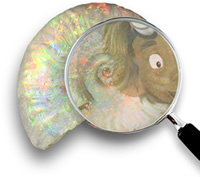
In the Lightning Ridge opal fields in New South Wales we can find something very special: opalised dinosaur bones. Opal is a beautiful gemstone which people often make into jewelry. Opals can be blue, green or pale, with sparkling fiery colours running through them when they catch the light.
The inland sea that previously existed in Australia retreated leaving behind something called silica. This seeped into the earth and hardened, forming opal. Ninety-six per cent of the world’s opal comes from Australia, so most opalised fossils are also found here.
Dinosaur bones become opalised when they are covered by rock and sediment. The bone then begins to rot away, allowing silica to creep into the cavity left behind. The silica hardens, creating an opal cast of the bone. In Australia, we can find opalised dinosaur bones, plants, turtles, mollusks, fish, sharks, snakes and all sorts of ancient life forms.
South Australia
During the Cretaceous period there was a group of dinosaurs called Hypsilodontids who lived in southern Australia. They were perfectly adapted for the cold weather and dark winters, with their large eyes allowing them to search for food such as ferns and moss, even in poor light. They would have been about the size of a wallaby and rather resembled one, running on their hind legs with a long tail.
Victoria and Western Australia
The remains of an Ozraptor were found near Geraldton in Western Australia. The Ozraptor was a bipedal, carnivorous Theropod that is thought to have been about three metres tall.
In Victoria, a large number of dinosaur bones have been found at various coastal locations, including a site called Dinosaur Cove and another called Flat Rocks. The most common dinosaurs found at these sites are called Hypsilophodontids.
What happened to the dinosaurs?
During the Cretaceous period something happened that caused the dinosaurs to disappear. The problem is that scientists are not actually sure what it was.
There are many theories as to what could have caused such huge creatures who had roamed the earth for so long to become extinct so rapidly. Theories include poisonous volcanic gases, a deadly virus, an asteroid, famine or climate change. Below are explanations of two of these theories.
Volcano theory

We already know that the Earth was undergoing major geographical change during the Cretaceous period. The land mass Pangaea had broken up into Laurasia and Gondwanaland, and then, 130 million years ago, these land masses were beginning to fragment to form our modern-day continents. All this moving and shifting could very well have resulted in volcanic eruptions and earthquakes which could have killed the dinosaur population.
Asteroid/Meteor theory
There is also evidence that this theory could be true, as, in Europe, scientists have found traces of iridium (a metal which is rare on Earth but common in meteorites). The asteroid theory suggests that asteroids entered the Earth’s atmosphere (becoming meteors) and hit the Earth. This caused the sky to fill with ash and dust which blocked the Sun and sent the Earth into a prolonged winter. This would have caused the temperature to fall and plants to die out, in turn killing the dinosaurs.
Dinosaur fast facts
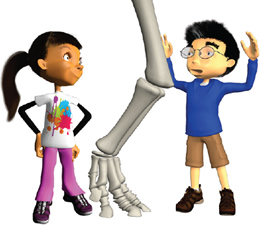
- In Ancient Greek the word dinosaur translates as ‘terrible lizard’.
- Scientists who study fossils are called paleontologists.
- Oddly enough, birds actually evolved not from the bird-hipped dinosaurs as their name suggests, but from the lizard-hipped dinosaurs!
- Dinosaur names often describe characteristics that scientists think they might have had. For example, Tyrannosaurus Rex means ‘Tyrant Lizard King’ and Velociraptor means ‘Swift robber’.
- Dinosaurs lived only on land and could not swim or fly. However, they lived alongside prehistoric water reptiles called Plesiosaurs, which were much like modern-day dolphins, as well as flying reptiles called Pterosaurs.
- The first ever dinosaur to be given a name was the Megalosaurus. It was named by Reverend William Buckland in 1824.
- Possibly the longest dinosaur that we know of is called Seismosaurus. It was around 25m tall and an astounding 45m in length. Its name comes from the Latin seismo meaning ‘of an earthquake’ and the Greek sauros meaning ‘lizard’.
- Have you heard of the movie called Jurassic Park? It was all about dinosaurs. When it was released it became the highest grossing film in the world, making $80 million dollars in its first week.
- Possibly one of the smartest known dinosaurs is the Troodon, which translates to ‘wounding tooth’. The Troodon was a fast and carnivorous theropod. He was not very big (not even as big as an adult human), but had one of the largest brains (in comparison to his body size) of any known dinosaur group.
References
The following links will direct you to the homepage of the websites used as references for this topic.
- Australian Broadcasting Corporation (ABC): www.abc.net.au
- Museums Victoria: museumsvictoria.com.au
- Australian Government Department of the Environment: www.environment.gov.au
- National Dinosaur Museum: www.nationaldinosaurmuseum.com.au




